More than 3000 wobbling stars (3044 planetary systems(2019) , in 2018 3741 planets and 2794 planetary systems detected whereas in 2011 only 527 extra-solar planetary systems detected and already more than 1000 by the beginning of 2014, 1854 planets and 1163 planetary systems in dec.2014 and in 2018 already 3741 planets / 2794 planetary systems / 625 multiple planet systems) can't be doubted by noone I can now reveal the full story behind it all: no scientific magazine would have published this theory (and all that I have sent it have refused to publish it(13)) because it strictly contradicts Einsteins theory of special relativity.
But since astronomers have found more than 3000 wobbling stars since 1995 which prove that all my calculations (dating as early as 1969) were correct, every single of the nearly 1000 wobbling stars proves that Einsteins theory must be wrong. You can ask a physics theorist to confirm this statement or simply read on.
All of these wobbling stars prove that Newton was correct (inherent in his own view) when he postulated that gravitational interactions between celestial bodies are instantanous, because he didn't knew anything about the important role of barycentres in star-planet systems(1). Since it was proven around 1900 that the speed of light is constant (follow the links here) and nothing was known to be faster than the speed of light, Einsteins special relativity theory fundamentally knows no propagation speed beyond the speed of light in vacuum, which is far from instantanous or infinite(2), so Einstein replaced the force by a geometric entity, space-time. Today, there are some processes discussed in which information or even particles seem to travel faster than light (see some examples here and also here: Superluminal motion of up to ~9.6c has been observed along the (inner) jet of this quasar. If you search the web, you'll find many examples like this one.). But wobbling stars don't fit in the picture of space-time curvature(3)(4)(12). As the latins used to say: "Quot erat demonstrandum".
Now since the wobbling of the stars sounds to everyone with a minimal physics understanding quite reasonable(11) and because astronomers didn't knew about these theoretical obstacles or didn't cared about, they started in the nineteeth of last century to search for wobbling stars when they heard of our wobbling sun. And these theoretical obstacles introduced by Einsteins theory of relativety were the reason why astronomers didn't search for wobbling stars during nearly 100 years after publication of Einsteins theory, not technical problems such as insufficient telescopes or spectroscopes. 2000 planet detections in the extremely short time of 20 years prove that it was not due to technical problems that before 1995 no planets orbiting other stars were known. And as the many links to amateur spectroscopy pages on doppler.htm prove, star spectroscopy or transiting planets detection can be accomplished today even with amateur equipment. More than twenty of these exoplanets were even detected with cheapest amateur mail order telescopes!(5)(6) or even telephoto lenses!!!!(7)(8) Not to mention the many amateur detections with slightly better eqipment. H.C.Vogel found already in 1890 wobbling stars by spectroscopic techniques!(9) Afterwards there was silence for 105 years.
as for instance in the simplest case the rubber sheet analogy shows (Since the concern of this site is not falsifying General relativity (GR) or Special Relativity (SR) only so much: The problem of gravity as a property of space-time geometry should get all too obvious to anybody with 3 and more bodies (if it isn't obvious enough with two bodies). That there is no provision for a barycentre in this theory can't be treated as a 'good enough approximation'. It's a severe contradiction to the laws of physics, which can't be dealed with as a minor slip or lapse. What has been true for years now as a counter argument to this thesis can't be wrong now, now that this thesis has been proven so many times. The small extra turns of the central body (see for instance the barycentric motions of stars below.) are absolutely not in any accordance with GR. Since this seems so hard to grasp for the smartest people in this world (the facts are known now for 20 years!) I will perhaps upload an extra page to this subject, although - as said - it is not my concern or intend to falsify GR or SR. ) And if you assume that General Relativity has been proven since long by many experiments, you can read in the above mentioned paper:"what do experiments say about the speed of gravity? The answer, unfortunately, is that so far they say fairly little. In the absence of direct measurements of propagation speed, observations must be filtered through theory, and different theoretical assumptions lead to different deductions. In particular,while the observed absence of aberration is consistent with instantaneous propagation (...), it is also consistent with the speed-of-light propagation predicted by general relativity." See also here. A good compilation to this subject you find here. But caution! This author is considered as non- mainstream, dubious and reading this may damage your mind And yes, Van Flandern expressed some strange views (Mars face etc..), but this doesn't means, that all his work is dubious. Mainstream compilation here and here (local copy here). But it seems at least some have noticed that the "Search for New Physics beyond General Relativity" has to start. This is a local copy since the arXiv file seems to be downloaded that much that it takes an eternity to open. If the excitement has passed, try this link. The critiques of GR get rapidly more in the last time, here is another and another. Also what has been attributed to Einstein and even the results are more and more questioned: "(..)these problems are non-trivial and (..)turn out to be relevant to the “4/3 problem". An important lesson of these analyses is that E = mc2, while extremely useful, is not a “law of physics” in the sense that it ought not be applied indiscriminately to any extended system and, in particular, to the subsystems from which they are comprised." If you search by yourself in arXiv, you will find many more, although some express their unease with GR very faint...
And btw all 'hard facts' experiments as in quantum physics speak also in favour of Newton.
Read here why Einstein was wrong.
A)Proven reality by measurements and observation:
barycentric motion of exoplanet host stars
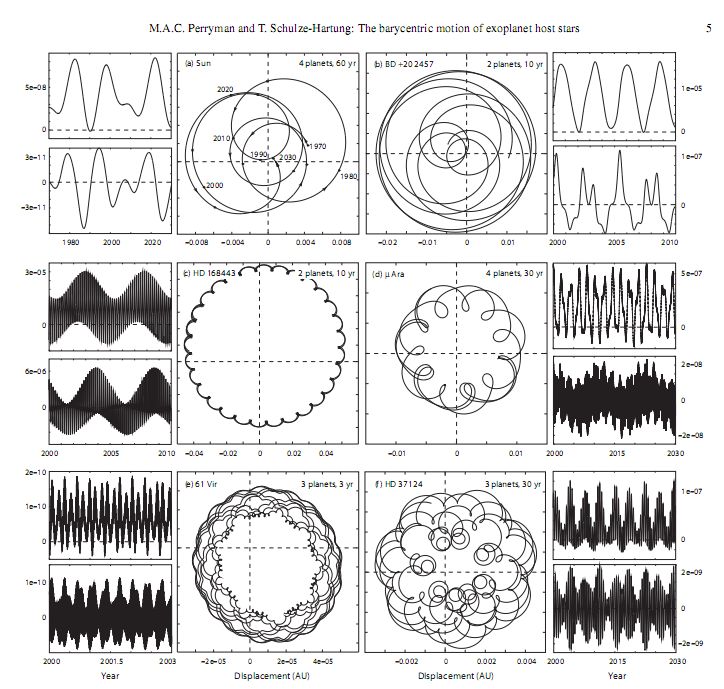
Source: http://arxiv.org/pdf/1010.0966v1
B)Todays theory: typical pictures of the dent that the sun (or the earth in the pictures below) produces in space-time geometry as you could see it on nearly every university server to Einsteins theory worldwide. As you can clearly see the sun is also in year 2011 still the gravitational center in these presentations of our solar system. There is simply no provision for a barycenter in this theory.
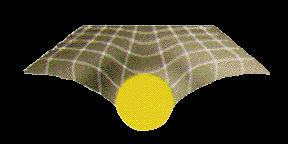 source:
http://imagine.gsfc.nasa.gov/docs/features/topics/
source:
http://imagine.gsfc.nasa.gov/docs/features/topics/
"Imagine pulling a sheet taut and placing a bowling ball in the center of it; you will notice that the ball produces a curve in the sheet. The curve is weak far away from the ball, and steeper near the ball. In fact, the sheet is a bit stretched in that area near the ball, as well. This situation describes the curvature of spacetime, and how it is affected by mass. Near a mass, spacetime curves more drastically and stretches. Near a very large mass, the 'dent' in spacetime is very deep, and the stretches are near the breaking point. This means that since spacetime stretches near a mass, not only is space stretched out, but so is time." ( http://imagine.gsfc.nasa.gov/docs/features/topics/ )
Another typical presentation:, this time in connection with cruel black holes (source http://www.cosmotography.com/images/supermassive_blackholes_drive_galaxy_evolution.html : "Just as a bowling ball placed on a trampoline stretches the fabric and causes it to dimple or sag, so planets and stars warp space-time - a phenomenon known as the 'geodetic effect'. Thus the planets orbiting the Sun are not being pulled by the Sun; they are following the curved space-time deformation caused by the Sun.")
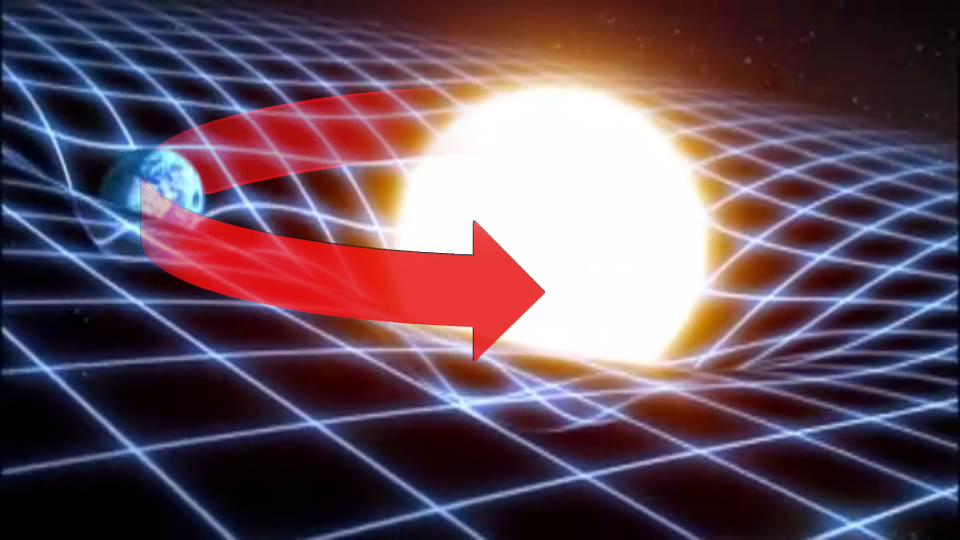
"Sun Curves Spacetime, Planets Follow the Straightest Paths" source: http://woodahl.physics.iupui.edu/Astro100/S3-13b_anno.jpg
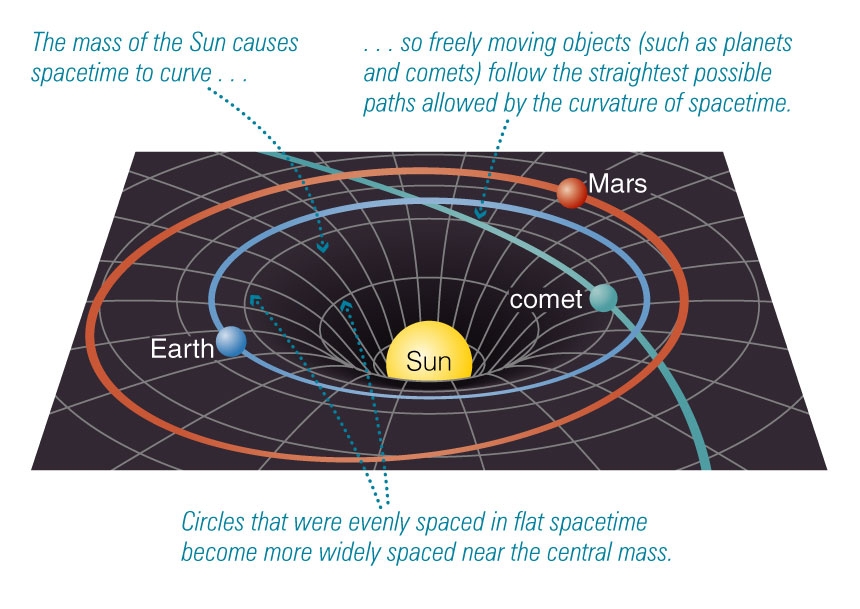
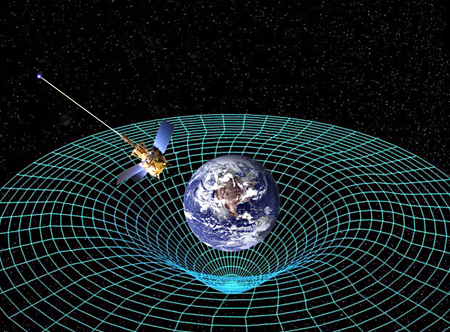 source:
http://news.stanford.edu/news/2005/may11/gpb-051105.html?view=print
source:
http://news.stanford.edu/news/2005/may11/gpb-051105.html?view=print
http://science.nasa.gov/science-news/science-at-nasa/2005/16nov_gpb/ :
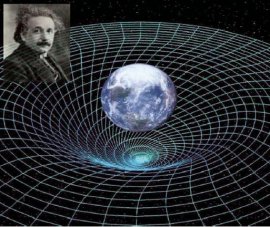
Finally: We should distinguish between emotions and physics: my sympathy for Einstein is in no way affected by this..